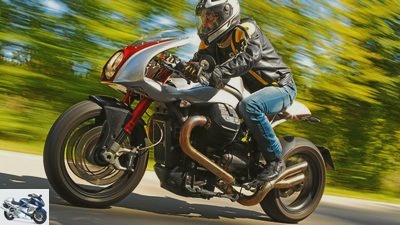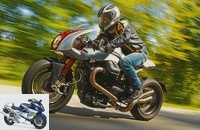Menus

Bilski
German-Italian conversion of a Moto Guzzi
Driving report Ipothesys Aria V12
Based on a Griso 8V, an Italian-German cooperation is creating a Moto Guzzi for which people like to lie flat: the Ipothesys, a radical rebel on wheels, a fascinating driving machine.
Grobstadt, arterial road, 60 km / h: a torture. Suburb, expressway, 80 km / h: it still hurts. Motorbike area, country road, 120 km / h: That’s quick! The wind pressure has to carry it with you in order to be able to support yourself on the damn distant and low-lying Andreani handlebars. Then the physical low turns into a mental high flight. Lying long, no ifs or buts. Kippers preferred, the cervical vertebrae should crack. This machine is just a rolling commitment, an appeal to Moto Guzzi: finally build us a contemporary, modern sports machine! 90 and a year and not a bit wise: it is difficult to understand why the traditional brand simply does not manage to build on its sporting roots and traditions . Which is why Guzzi disciples have to wait in vain for the latest interpretations of a V7 Sport or Le Mans I. But – the name Ipothesys (hypothesis) suggests – there should really be opportunities for classy driving machines with the original V2 engine. To fill this gap, Alessandro Loviselli designed the Ipothesys Aria V12. And created pure magic with it!
Buy complete article

German-Italian conversion of a Moto Guzzi
Driving report Ipothesys Aria V12
Bilski
Only the two cylinder sticks and the handlebar end mirrors protrude from the slim, daring silhouette.
The highlight of the design is on the lower ground floor, an exhaust like a sculpture, reduced to the maximum: Arm-thick elbow boas flicker on both sides, not crossed backwards as in the Griso. Without a major collector, but with a catalytic converter and two lambda sensors. On the left, the manifolds flow into boldly stacked exhaust pipes. Radically cut, they completely reveal the rear wheel, which is only guided on the right. Nobody of the onlookers expects serious sound insulation. But the Shark dampers take their job surprisingly seriously. The V2 wakes up with a bark, but not loudly. He rolls out a carpet of sound, not a boom.
Alessandro Loviselli is a classical guitarist. A good sound, like an Italian aria, becomes a matter of honor: the melodious exhaust system is tuvt like the other attachments – after extensive revision by the Guzziladen from Schwarzenfeld. Kalonk, with the charm of a railway signal box, the gears of the first gear “slide” in. The standard transmission also audibly accompanies all gear changes with loud gear shifts. It doesn’t matter, because you roll off the courtyard with the aura of riding a real men’s motorcycle.
That makes thieving joy. The brawny power output even more so. After 90 Newton meters of starting torque, the V2 quickly swings up to a fat 111 Newton meters at 5000 tours. That means surfing on a fat wave. Because up to this speed, a standard Griso first falls into a torque hole and only piles up as much pressure at 6500 rpm. The 1151 cubic engine remained untouched. The only thing that has changed is its periphery, the airways. Plus a freely programmable, self-learning power commander. The result is a torque giant instead of a performance giant: At the top, the four-valve V2 with the rudimentary exhaust completely runs out of breath. A standard Griso expresses a real 108 hp, the Ipothesys only lets 86 horses out of the stable. Their motto: more experience per kilometer instead of more kilometers per hour.
Bilski
Crouched, sinewy, elongated: Honest metal, tightly cut plastic parts and rudimentary rear frame make you sensual.
Well, but not greedy, the engine depends on the gas. He has easy play with the 225 kilograms; a standard Griso weighs a whopping 23 kilos more. Despite the cardan support, load change reactions can be felt. The Italian interpretation of a cafe racer wants to be led with a bold hand in alternating curves. It does what it should, is neither stubborn nor overhanded. Having to plow a little bit goes well with the desire to take the bull by the horns. If you circle old-school curves with an even pull on the cable, the Aria is pretty accurate.
The short lever arm of the steering stub compensates for the small gyroscopic forces of the light forged wheels. Metzeler Sportec M3 take their liability very seriously, make you really sporty. But be careful: only to the right is the freedom to incline almost unlimited. To the left, however, the standard boom of the side stand is waiting to pry you out. So curb. The chassis provides sensitive information about the nature of the asphalt relief without being particularly comfortable. Really feeling.
A fat 50s Marzocchi fork works at the front, a very stiff Bitubo shock absorber with a reservoir at the rear. It’s the tough kind. The hindquarters can wedge out on extremely bad surfaces. Then grab the handlebars. Who tells whom where it’s going? No compromise. The crisp coordination fits the concept of the crouched muscle man like the almond cookie with cappuccino. The turning circle is a real disaster: a huge 8.75 meters! Despite the minimal steering angle, the steering stubs hit the fairing. Brembo four-piston stoppers, actuated by a radial pump, catch the Aria V12 easily controllable.
The second Ipothesys produced already received many modified details: It has a 50 millimeter longer rear, an aluminum tank and a more elegant front panel. Even a fully disguised version should follow soon. There is still room for improvement, the hypothesis that such pure driving machines from Mandello del Lario are currently missing.
Conversion information
Bilski
Lustful: The flat iron needs to be handled properly. Then it follows the curve of the room fairly precisely.
The prototype of the Aria V12 driven here was conceived and drawn by Alessandro Loviselli. He is the head of Ipothesys Motorcyle. He brought committed Guzzi specialists to the team, such as Filippo Barbacane and Bruno Birnes, Guzzi dealers from Brescia. For the upcoming small series, Stefan Bronold, owner of the Guzziladen in Schwarzenfeld, will be responsible for the production of the milled parts, assembly and approval (all approved!). He also takes care of sales outside of Italy. On the hand-carved prototype, some details still seem quite rustic to improvised. But improvements have been made since the second model, such as CNC-milled or laser-cut metal parts. An Ipothesys of this type costs around 30,000 euros. With standard suspension elements and series wheels of a Griso 8V it can also be cheaper. A pure optics kit for minimal conversions should cost 3000 to 4000 euros, including the exhaust system 7000 to 8000 euros.
Contact: www.ipothesys.it, Guzziladen: Nabburger Str. 40, 92521 Schwarzenfeld, Telephone 0 94 35/6 39 32 67, www.guzziladen.de
Related articles
-
Driving report Moto Guzzi Griso 8V
Bilski Driving Report Moto Guzzi Griso 8V With Two Game Four Traditionally, Moto Guzzi relies on two cylinders. Classically air-cooled, lengthways, in …
-
Driving report Moto Guzzi California Special and Quota 1100 ES
Driving report Moto Guzzi California Special and Quota 1100 ES Magical powers Forza in movimento – power lies in movement: With new models from …
-
Driving report Moto Guzzi Stelvio 1200 NTX
Moto Guzzi 17 pictures Moto Guzzi 1/17 Don’t be intimidated: the NTX looks mighty like a Dolomite peak, the seat height from 820 to 840 …
-
Driving report Moto Guzzi Breva V 1100
fact driving report Moto Guzzi Breva V 1100 Una Storia Italiana The story of the long announced Moto Guzzi Breva V 1100 is a typical …
-
Moto Guzzi V7 II Special in the driving report
fact 7 pictures fact 1/7 Moto Guzzi V7 II Special fact 2/7 The Moto Guzzi V7 II Special is not a marketing product of the rampant retro wave, … fact …
-
Moto Guzzi MGX-21 in the driving report
www.zamponi.net 13 pictures Moto Guzzi 1/13 Moto Guzzi MGX-21. Moto Guzzi 2/13 Moto Guzzi MGX-21. Moto Guzzi 3/13 Batman would drive excavators … Moto Guzzi …
-
Driving report Moto Guzzi MGS-01 Corsa
Gori driving report Moto Guzzi MGS / 01 Corsa Adler learns to fly In autumn she was one of the stars of Intermot. The MGS / 01 study not only provided …
-
Driving report Moto Guzzi Breva V 750 IE
Driving report Moto Guzzi Breva V 750 IE WIND MILL With the new Breva V 750 IE, Moto Guzzi wants to bring a breath of fresh air into the middle class and with full …
-
Vanguard Moto Guzzi V8 in the driving report
Vanguard 13 pictures Vanguard 1/13 picture gallery: Vanguard Moto Guzzi V8. Vanguard 2/13 driving? Quite feasible on the Vanguard V8, but a rather …
-
Artistic driving report Moto Guzzi (2009) The new 1200 Sport 4V is called where the eagle lives. No less than eleven kings of the skies have seen the latest creation from …